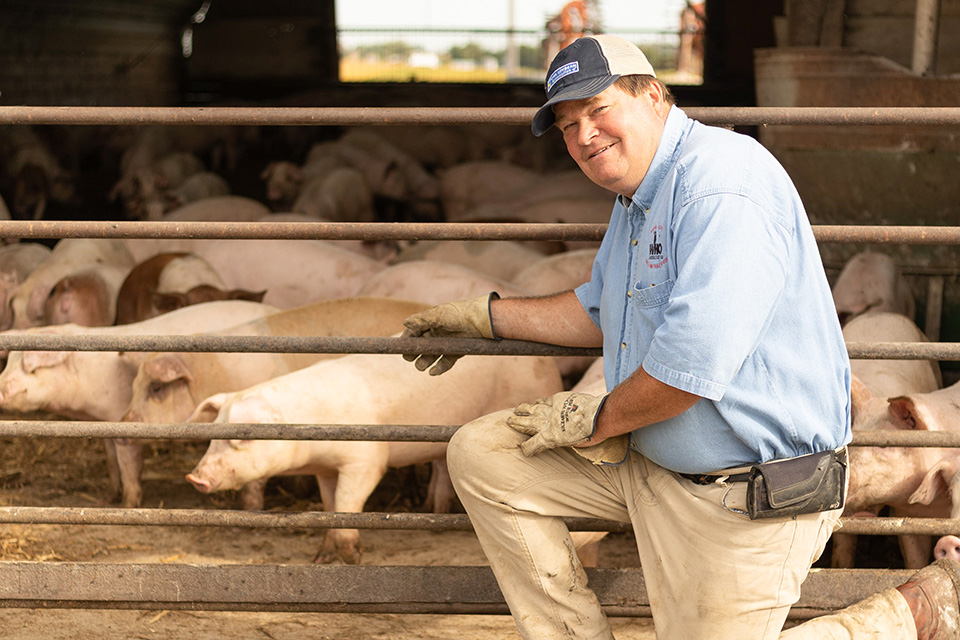
Iowa Soybean Association District 5 Director Dave Struthers on his farm near Collins. Like other pig farmers, Struthers is watching his feed costs closely as farmers face negative financial returns. (Photo: Iowa Soybean Association / Joclyn Bushman)
Managing in unprofitable territory
January 25, 2024 | Bethany Baratta
Last year was one for the record books for farrow-to-finish pig farmers—but for all the wrong reasons.
Farrow-to-finish operators in Iowa averaged a nearly $28-per-head loss in 2023, worse than 1998, when pork producers saw an average loss of $22.19 per head.
Profitability is expected to improve in 2024, experts at the Iowa Pork Congress said this week, but the returns are still expected to be in the red. Average “profits” per head in 2024 are expected at -$8.79 per head.
Returns are expected to be less negative as feed prices decline, says Steve Meyer, a lead economist for Ever.Ag. Meyer has served as a leading expert in pork economics for decades.
“Buy as low as you can does not mean buy low, just buy lower,” Meyer told Iowa Pork Congress attendees in Des Moines.
By tightening up his feed and production costs, Iowa Soybean Association (ISA) District 5 Director Dave Struthers was able to break even in 2023. Struthers, a past president of the Iowa Pork Producers Association, purchases feeder pigs near Collins. He’s looking at positive returns in 2024.
“It’s still looking pretty bleak for farrow to finish operators,” Struthers says, lamenting on conversations with friends in the industry who are pivoting their operations from raising sows and piglets to wean-to-finish operations.
There were 75 million hogs and pigs in the U.S. as of Dec 1, 2023, the latest U.S. Department of Agriculture (USDA) Hogs and Pigs report said. The total inventory was up slightly from the previous year, but the breeding inventory—at 6 million—was down 3% from 2022.
Though no pig is completely immune to illness, farrow-to-finish operators face greater risk (and costs) of the porcine reproductive and respiratory syndrome (PRRS) causing longer-term impacts to their breeding stock as the virus impacts the health of breeding stock and piglets.
“These (farrow-to-finish) operators have to move pigs and have to price them lower for guys like me to buy,” Struthers says. “They’re still getting hurt, but the lower cost pigs keep me viable. I’m getting the advantage, but I want everybody to make some money.”
Feed costs—which constitutes two-thirds the costs of raising pigs—are heading in the right direction for pig farmers. Still, Iowa State University economists forecast feed costs at $80 per head for the foreseeable future.
Struthers notes that he’s benefitted as a diversified crop and livestock farmer. He’s able to use some of the grain produced on his farm to feed his pigs.
“Being a smaller operation, I can’t say labor costs have changed, but we’ve been able to control our feed costs somewhat,” Struthers said on his way outdoors to haul feed to his pigs. “The fact that we raise the crop, use the grain for feed, and use the livestock manure to feed our soil is valuable.”
Iowa’s pork industry is responsible for consuming 23% of Iowa soybean acres and 22% of Iowa corn acres. From wean to market (270 lbs.), a pig consumes approximately 12 bushels of corn and 2.5 bushels of soybeans.
It’s not a year to add more pig spaces or grow the farm, Struthers says.
“The best scenario is for hog prices to rise and grain farmers to be profitable,” he says. “Right now, we’re looking at a small profit for 2024—toying with unprofitable territory. It’s not a year for trading tractors or combines; we’re managing what we have.”
Back